Presentation Mask: designers and PR people are still winning engineers
A year ago, I commented on the presentation of Ilona Musk at the 67th International Astronautical Congress. This year the following presentation was presented at the congress. Over the past week, not only comments, but also comments to comments, have appeared, but I still find it useless to compare presentations and express a couple of my thoughts.
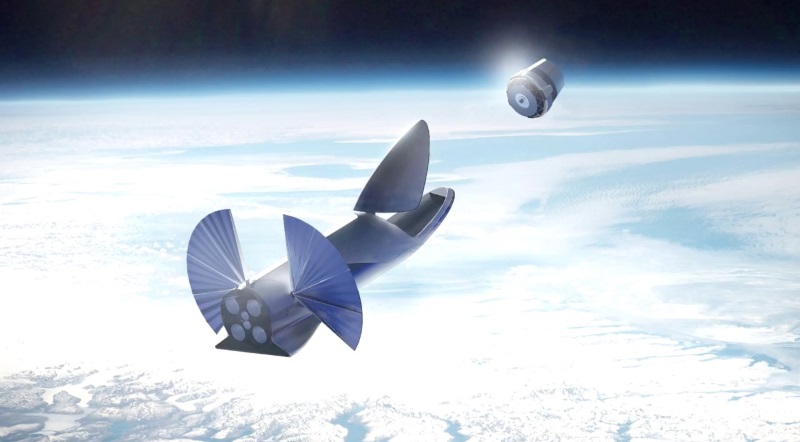
A new version of the BFR displays satellite, drawing SpaceX
My main complaint about the previous presentation was that instead of a detailed technical project we were shown something between a design concept and a dream. The fact that a year later the BFR has seriously decreased (from 7,000 tons of initial mass to 4,400, from 500 tons of carrying capacity to 150) rather indicates that this claim was correct - well-designed projects do not change so much.
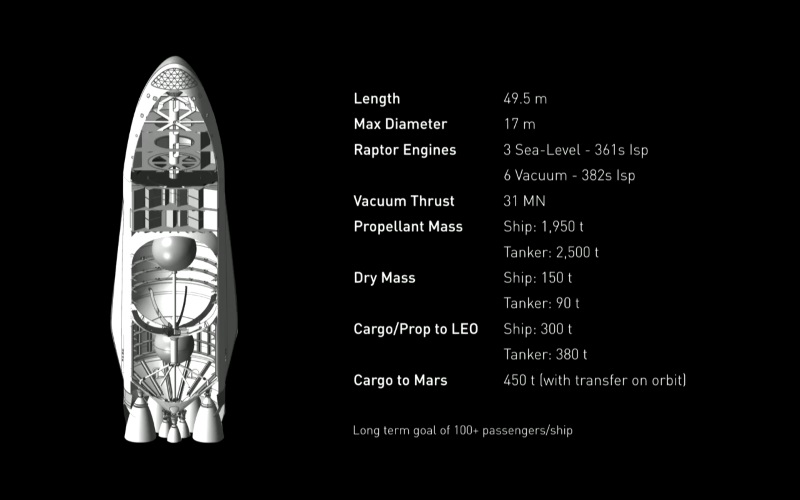
Last year's version of the ship, hereinafter illustrations SpaceX
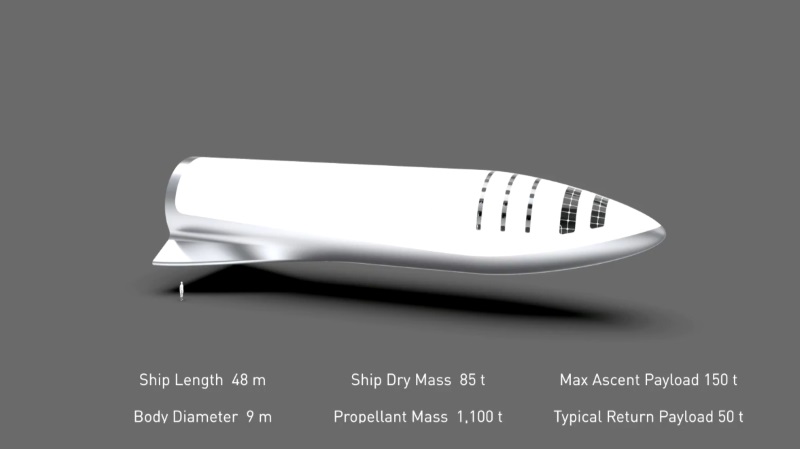
Version of this year
Over the past year, the ship (second stage) decreased in mass from 150 tons to 85, and the overall diameter of the system fell from 12 meters (17 with projections) to 9. The question naturally arises whether the BFR will change further? In my opinion, yes. Despite the greater likelihood (finally turning up solar panels appeared), the concept still shows quite irrationally huge portholes, albeit smaller than last year. The space porthole is heavier than a conventional case, therefore, with real design, they are thrown out with the exception of a few very small ones. Calculating the number of passengers according to the number of cabins directly shows that there was no serious design there yet - the capacity of the life support system and the required amount of reserves determine the maximum number of passengers, and not how many cabins a person will be able to place in the cabin. In general, it is not clear from the presentation which SpaceX targets the numerical parameters when designing its system, so BFR can grow as well as decrease further. It will be funny if in the end in a few years BFR will lose weight to the equivalent of New Glenn tons by fifty to a low orbit. Finally, it is worth noting that the size of the space system is often the determining factor for its success or failure, and since we do not know the future, it has to be guessed. The family "R-7" or Falcon 9 with the size of luck, but, for example, Ariane 5, alas, no.
In the presentation of this year, BFR has a new potential source of income - suborbital passenger traffic. The cosmonautics pioneers dreamed about this, but the world has changed a lot, and now this dream has faded noticeably. First of all, with the development of telecommunications and unlimited tariffs on the Internet, you can instantly and without special surcharge contact the subscriber at the opposite point of the Earth, arrange a teleconference, receive and transmit video. As for the movements in the physical body, here the long-term development of aviation has shown that people prefer to fly cheaper, even if it takes more time - the supersonic "Concords" have become extinct for economic reasons. It will be very difficult to compete with the developed air transport market with an extensive ground infrastructure. Even if the rocket service turns out to be very cheap, it will be necessary to build space ports in cities, and this is both time and money. And finally, the slogan “To any point of the Earth in less than an hour” has little to do with reality - if you flew by plane, remember that you need to get to the airport of departure, check in, get on a plane, move from an airplane after landing to the airport of arrival and from there to the destination, and these operations often take longer than the flight itself.
The extremely interesting feature of the declared BFR-2017 is its versatility - the same ship is supposed to be made suitable for suborbital passenger traffic, commercial payload, flights to the Moon and Mars. The problem here is that landing on different celestial bodies makes conflicting demands. For the moon's airless environment, the wings and thermal protection will be a dead weight. On Mars, due to the lesser gravity and density of the atmosphere, the equilibrium speed (the speed at which the resistance force of the atmosphere is equal to the force of gravity, the minimum speed to which you can brake at the expense of the atmosphere) is about five times higher than Earth's, that is, the same ship will forced to extinguish five times greater speed during a rocket landing on Mars than on Earth. The phrase about landing “anywhere in the Solar System” has to be taken as an artistic exaggeration, because otherwise the design turns out to be quite implausible.

The idea of using a universal connector for refueling is good, but the concept of a natural overflow of fuel under the engines looks quite strange - the turbo pump even “on the fingers” looks more efficient. By the way, there are no separate cylinders of the pressurization system in the diagram, they either forgot about it or intend to use less common systems with gasification of components or special gas generators. There are many interesting questions there, and I would not hesitate to exchange a couple of beautiful pictures about the exploration of Mars for a story about solving this issue.
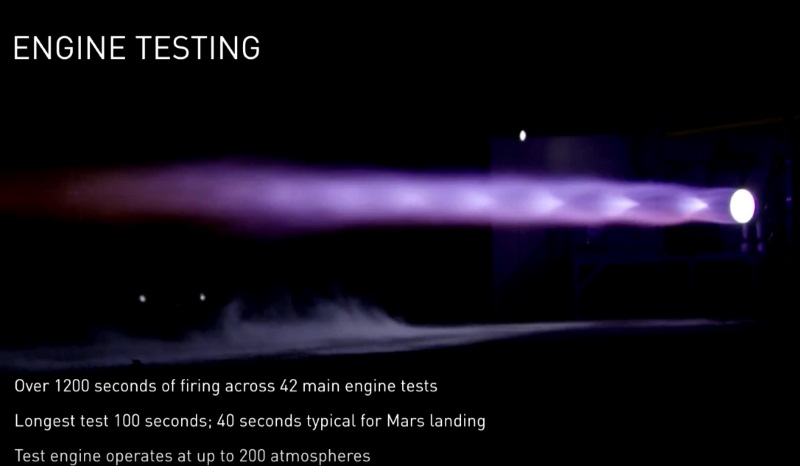
Raptor Engine Tests
It’s good that the work on the Raptor methane engine is going well, and it’s a pity that the “specific engine thrust” parameter is still used for marketing purposes as a measure of its effectiveness (why here ). But the 200 atmospheres achieved in the tests in the combustion chamber are a great success. It will be very interesting to see if they can eventually achieve the promised 300 atmospheres.
The idea of planting the first step back to the launching facility, which survived from last year, looks strange. First of all, conventional rockets are attached to the launching table by pyrobolts, and just so the rocket will not stand back on the table - special locking devices will be needed even with a perfect fit. Further, an error in the final landing stage means damage to the start, which can be costly. Returning to the launch site eats up a significant portion of the payload, and on the Falcon 9 it was used only to output very light satellites. Finally, the ship has landing legs at the presentation of suborbital flights, and there are no launch facilities on the barge, and they are unnecessary there.
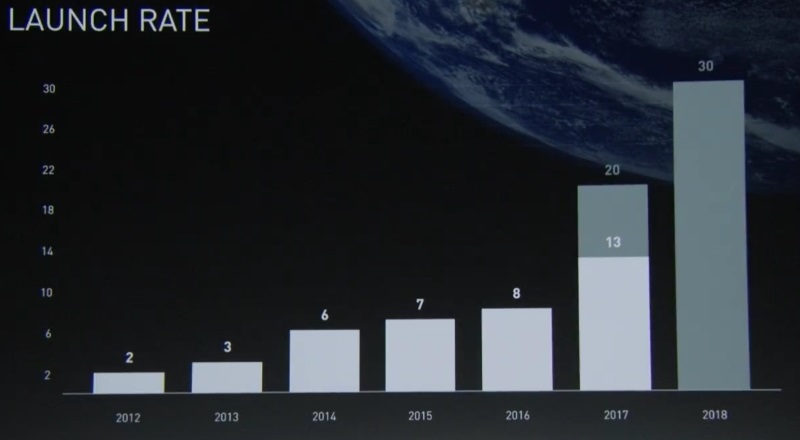
A sad smile is caused by reasoning about an exponential increase in the number of launches, thousands of ships, tens of thousands of launches for refueling, and several launches a day just for mastering Mars. Alas, any single technology has a limit, and instead of developing exponentially, a logistic curve is obtained . We write the promise of 30 starts in 2018 and see if we can complete it.
Against such a background, the next slide looks funny, where Musk in every way praises the "key" technology of automatic docking. Yes, for SpaceX it will be a new skill, but, the right word, the USSR performed the first automatic docking back in 1967, this is already a space routine.
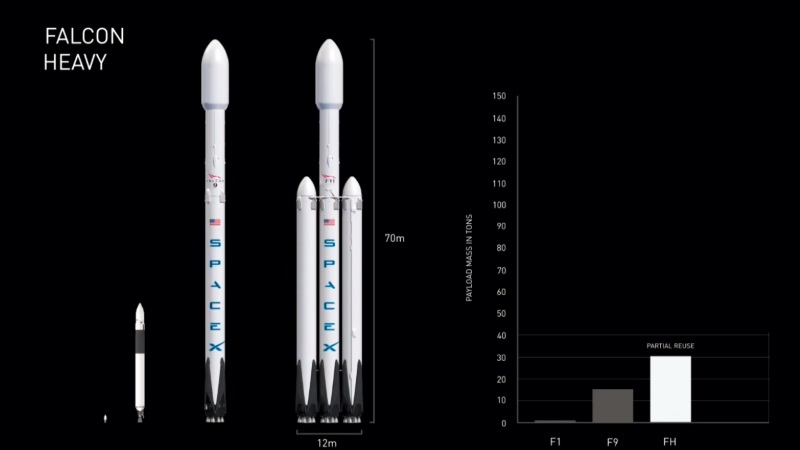
And here, without any special comments, interesting figures are mentioned - the capacity of the Falcon Heavy in a partially reusable version is indicated at 30 tons. Against the background of the fact that the one-time version of the declared capacity has increased from 56 to just above 60 tons, it looks like a vivid and sad illustration of the cost of reusability.

Obviously, the cost of a kilogram is considered here, and the expected BFR high carrying capacity makes it more profitable (see the concept of “big silly carrier” ), but the declared lead in the cost of elimination looks impressive anyway. It is a pity that again, already some year, the mantra “fuel is cheap, rocket is expensive, let's do reusable rockets”. Alas, many other factors affect the cost of both a plane ticket and a kilogram into orbit (see the most obvious problems and the failure history of the Space Shuttle ).
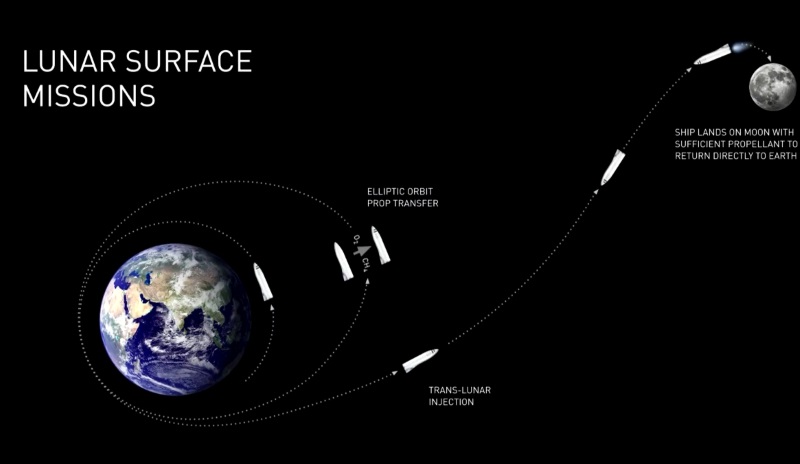
The declared possibility of a flight to the moon with the return on one ship (without discarding the spent stages) looks very attractive, provided that it is replenished in a high elliptical orbit. Theoretically, such a decision could make the moon much more accessible.

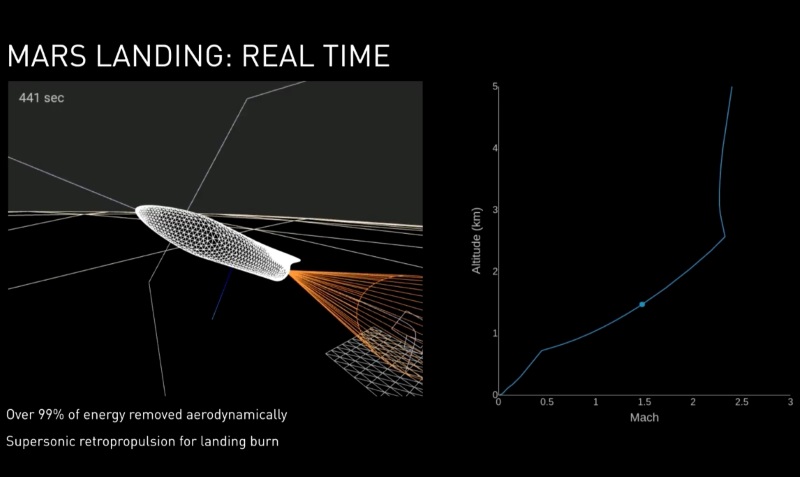
Last year, I wrote that the idea of landing on Mars in a horizontal and vertical position looks implausible. It’s good that at least approximate calculations of such a landing are shown this year - at the first stage, the device quenches the speed of encounter with the planet and goes on to climb, and at the second stage it slows down with engines and makes a landing. The idea looks unique, I can not remember this in history, and, obviously, it will be difficult to do, but the mathematical model is the first step towards realization.
It is extremely curious that ablation heat protection is used in the ship (this was emphasized several times in the presentation). Unlike shuttle-style tiles, it will burn out and will have to be changed, which raises additional questions about the cost and complexity of reuse.

But this slide should be shown to anyone who seriously dreams about thousands of launches per year and exploration of Mars in the 2020s. The fact is that SpaceX plans to have a research ship Red Dragon - a modification of Dragon v2 for landing on Mars. Initially, it was about to be launched in 2018. Then the dates moved to 2020, and in the summer of 2017 it was canceled. Now they show us a much larger BFR and call the term - 2022. Today, Mask has no experience of landing even relatively small spacecraft on Mars, SpaceX is known for regular postponement, and we are promised to land a ship weighing about a hundred tons (a hundred times heavier than any spacecraft landing on Mars!) Just five years later. Alas, it looks very implausible, and beautiful pictures of the Martian settlement are perceived as pure fiction.
At the beginning of the presentation, Musk tried to explain why it is important for humanity to become an interplanetary view. In his opinion, such a future looks much more attractive, and people want to wake up in the morning inspired, with the feeling that the future is beautiful. But in fact, he got an explanation of the meaning of the presentation - we were again shown a beautiful dream. Yes, it will be much more pleasant for someone to wake up with faith in the glittering future of space exploration with BFR, but, in my opinion, changing dreams every year is not a very good motivator, and I would like to have more boring, but more realistic and detailed plans. .

A new version of the BFR displays satellite, drawing SpaceX
Universal sturgeon
My main complaint about the previous presentation was that instead of a detailed technical project we were shown something between a design concept and a dream. The fact that a year later the BFR has seriously decreased (from 7,000 tons of initial mass to 4,400, from 500 tons of carrying capacity to 150) rather indicates that this claim was correct - well-designed projects do not change so much.

Last year's version of the ship, hereinafter illustrations SpaceX

Version of this year
Over the past year, the ship (second stage) decreased in mass from 150 tons to 85, and the overall diameter of the system fell from 12 meters (17 with projections) to 9. The question naturally arises whether the BFR will change further? In my opinion, yes. Despite the greater likelihood (finally turning up solar panels appeared), the concept still shows quite irrationally huge portholes, albeit smaller than last year. The space porthole is heavier than a conventional case, therefore, with real design, they are thrown out with the exception of a few very small ones. Calculating the number of passengers according to the number of cabins directly shows that there was no serious design there yet - the capacity of the life support system and the required amount of reserves determine the maximum number of passengers, and not how many cabins a person will be able to place in the cabin. In general, it is not clear from the presentation which SpaceX targets the numerical parameters when designing its system, so BFR can grow as well as decrease further. It will be funny if in the end in a few years BFR will lose weight to the equivalent of New Glenn tons by fifty to a low orbit. Finally, it is worth noting that the size of the space system is often the determining factor for its success or failure, and since we do not know the future, it has to be guessed. The family "R-7" or Falcon 9 with the size of luck, but, for example, Ariane 5, alas, no.
In the presentation of this year, BFR has a new potential source of income - suborbital passenger traffic. The cosmonautics pioneers dreamed about this, but the world has changed a lot, and now this dream has faded noticeably. First of all, with the development of telecommunications and unlimited tariffs on the Internet, you can instantly and without special surcharge contact the subscriber at the opposite point of the Earth, arrange a teleconference, receive and transmit video. As for the movements in the physical body, here the long-term development of aviation has shown that people prefer to fly cheaper, even if it takes more time - the supersonic "Concords" have become extinct for economic reasons. It will be very difficult to compete with the developed air transport market with an extensive ground infrastructure. Even if the rocket service turns out to be very cheap, it will be necessary to build space ports in cities, and this is both time and money. And finally, the slogan “To any point of the Earth in less than an hour” has little to do with reality - if you flew by plane, remember that you need to get to the airport of departure, check in, get on a plane, move from an airplane after landing to the airport of arrival and from there to the destination, and these operations often take longer than the flight itself.
The extremely interesting feature of the declared BFR-2017 is its versatility - the same ship is supposed to be made suitable for suborbital passenger traffic, commercial payload, flights to the Moon and Mars. The problem here is that landing on different celestial bodies makes conflicting demands. For the moon's airless environment, the wings and thermal protection will be a dead weight. On Mars, due to the lesser gravity and density of the atmosphere, the equilibrium speed (the speed at which the resistance force of the atmosphere is equal to the force of gravity, the minimum speed to which you can brake at the expense of the atmosphere) is about five times higher than Earth's, that is, the same ship will forced to extinguish five times greater speed during a rocket landing on Mars than on Earth. The phrase about landing “anywhere in the Solar System” has to be taken as an artistic exaggeration, because otherwise the design turns out to be quite implausible.

The idea of using a universal connector for refueling is good, but the concept of a natural overflow of fuel under the engines looks quite strange - the turbo pump even “on the fingers” looks more efficient. By the way, there are no separate cylinders of the pressurization system in the diagram, they either forgot about it or intend to use less common systems with gasification of components or special gas generators. There are many interesting questions there, and I would not hesitate to exchange a couple of beautiful pictures about the exploration of Mars for a story about solving this issue.
Presentation

Raptor Engine Tests
It’s good that the work on the Raptor methane engine is going well, and it’s a pity that the “specific engine thrust” parameter is still used for marketing purposes as a measure of its effectiveness (why here ). But the 200 atmospheres achieved in the tests in the combustion chamber are a great success. It will be very interesting to see if they can eventually achieve the promised 300 atmospheres.
The idea of planting the first step back to the launching facility, which survived from last year, looks strange. First of all, conventional rockets are attached to the launching table by pyrobolts, and just so the rocket will not stand back on the table - special locking devices will be needed even with a perfect fit. Further, an error in the final landing stage means damage to the start, which can be costly. Returning to the launch site eats up a significant portion of the payload, and on the Falcon 9 it was used only to output very light satellites. Finally, the ship has landing legs at the presentation of suborbital flights, and there are no launch facilities on the barge, and they are unnecessary there.

A sad smile is caused by reasoning about an exponential increase in the number of launches, thousands of ships, tens of thousands of launches for refueling, and several launches a day just for mastering Mars. Alas, any single technology has a limit, and instead of developing exponentially, a logistic curve is obtained . We write the promise of 30 starts in 2018 and see if we can complete it.
Against such a background, the next slide looks funny, where Musk in every way praises the "key" technology of automatic docking. Yes, for SpaceX it will be a new skill, but, the right word, the USSR performed the first automatic docking back in 1967, this is already a space routine.

And here, without any special comments, interesting figures are mentioned - the capacity of the Falcon Heavy in a partially reusable version is indicated at 30 tons. Against the background of the fact that the one-time version of the declared capacity has increased from 56 to just above 60 tons, it looks like a vivid and sad illustration of the cost of reusability.

Obviously, the cost of a kilogram is considered here, and the expected BFR high carrying capacity makes it more profitable (see the concept of “big silly carrier” ), but the declared lead in the cost of elimination looks impressive anyway. It is a pity that again, already some year, the mantra “fuel is cheap, rocket is expensive, let's do reusable rockets”. Alas, many other factors affect the cost of both a plane ticket and a kilogram into orbit (see the most obvious problems and the failure history of the Space Shuttle ).

The declared possibility of a flight to the moon with the return on one ship (without discarding the spent stages) looks very attractive, provided that it is replenished in a high elliptical orbit. Theoretically, such a decision could make the moon much more accessible.


Last year, I wrote that the idea of landing on Mars in a horizontal and vertical position looks implausible. It’s good that at least approximate calculations of such a landing are shown this year - at the first stage, the device quenches the speed of encounter with the planet and goes on to climb, and at the second stage it slows down with engines and makes a landing. The idea looks unique, I can not remember this in history, and, obviously, it will be difficult to do, but the mathematical model is the first step towards realization.
It is extremely curious that ablation heat protection is used in the ship (this was emphasized several times in the presentation). Unlike shuttle-style tiles, it will burn out and will have to be changed, which raises additional questions about the cost and complexity of reuse.

But this slide should be shown to anyone who seriously dreams about thousands of launches per year and exploration of Mars in the 2020s. The fact is that SpaceX plans to have a research ship Red Dragon - a modification of Dragon v2 for landing on Mars. Initially, it was about to be launched in 2018. Then the dates moved to 2020, and in the summer of 2017 it was canceled. Now they show us a much larger BFR and call the term - 2022. Today, Mask has no experience of landing even relatively small spacecraft on Mars, SpaceX is known for regular postponement, and we are promised to land a ship weighing about a hundred tons (a hundred times heavier than any spacecraft landing on Mars!) Just five years later. Alas, it looks very implausible, and beautiful pictures of the Martian settlement are perceived as pure fiction.
Conclusion
At the beginning of the presentation, Musk tried to explain why it is important for humanity to become an interplanetary view. In his opinion, such a future looks much more attractive, and people want to wake up in the morning inspired, with the feeling that the future is beautiful. But in fact, he got an explanation of the meaning of the presentation - we were again shown a beautiful dream. Yes, it will be much more pleasant for someone to wake up with faith in the glittering future of space exploration with BFR, but, in my opinion, changing dreams every year is not a very good motivator, and I would like to have more boring, but more realistic and detailed plans. .
All Articles